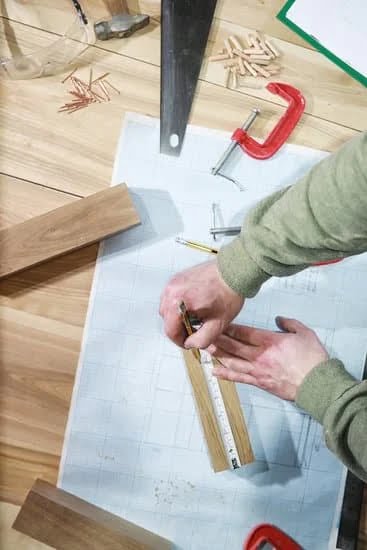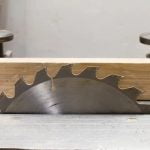Woodwork can add a touch of elegance and beauty to any space, but even the most skilled carpenters can encounter the challenge of dealing with large gaps in their projects. Whether it’s due to shrinkage, expansion, or poor craftsmanship, these gaps can be unsightly and compromise the structural integrity of the woodwork. In this article, we will explore how to fill large gaps in woodwork effectively and restore its natural beauty.
Understanding the causes behind these gaps is crucial in finding the right solution. Shrinkage and expansion caused by changes in humidity and temperature can lead to noticeable gaps over time. Additionally, poor craftsmanship or improper joinery techniques may also result in significant gaps that cannot be ignored. By identifying the root cause of these gaps, we can take appropriate measures to address them effectively.
Measuring and assessing the size of the gap is an essential step before beginning any filling work. Accurate measurements ensure that you choose the right filling material for a long-lasting repair. Whether it’s epoxy putty, wood fillers, or custom-made filler mixtures, there are various options available in the market. Each has its pros and cons when it comes to durability, flexibility, and ease of use.
In this article, we will guide you through each step of filling large gaps in woodwork. From preparing the gap for filling to choosing the right material and achieving a seamless finish, we’ll provide detailed instructions for every stage of the process. Additionally, we’ll discuss proper sanding techniques and finishing touches to ensure a professional-looking result.
By addressing not only how to fill large gaps but also how to prevent future ones from occurring, this article aims to equip you with valuable knowledge for your woodworking projects. With patience, precision, and utilizing appropriate materials and techniques, you can successfully repair those unsightly gaps and restore your woodwork’s beauty for years to come.
Understanding the Causes
Large gaps in woodwork can be an unsightly and frustrating issue to deal with. Understanding the causes behind these gaps is crucial in order to effectively address and fix them. There are several reasons why large gaps may occur in woodwork, including shrinkage, expansion, or poor craftsmanship.
One of the main causes of large gaps in woodwork is shrinkage. Wood naturally expands and contracts with changes in temperature and humidity. As a result, if the wood is not properly acclimated or if it is exposed to extreme environmental conditions, it can shrink and create gaps. In some cases, improper installation or inadequate fastening techniques can also contribute to shrinkage and the formation of gaps.
On the other hand, expansion can also cause large gaps in woodwork. This typically occurs when moisture levels increase or when there is excessive humidity. As the wood absorbs moisture, it swells and expands, which can lead to the formation of gaps between pieces of wood or between the wood and other materials.
Lastly, poor craftsmanship can be a significant factor contributing to large gaps in woodwork. If the joints are not properly fitted or if there are inconsistencies in the construction process, gaps may develop over time. Additionally, using low-quality materials or not following proper woodworking techniques can also result in noticeable gaps.
To effectively address large gaps in woodwork, it is essential to first identify the specific cause of the gap. This will help determine the most appropriate filling technique and material to use for repair. Whether it is addressing shrinkage, expansion, or poor craftsmanship, taking the time to understand the cause behind these gaps will ultimately lead to a more successful repair.
| Cause | Definition |
|---|---|
| Shrinkage | The natural process where wood shrinks due to changes in temperature and humidity. |
| Expansion | The process where wood swells and increases in size due to increased moisture levels or humidity. |
| Poor Craftsmanship | Inconsistencies in construction, improper fittings, or the use of low-quality materials resulting in noticeable gaps. |
Assessing the Gap Size
Accurately assessing the size of a gap in woodwork is crucial in order to choose the right filling material for the repair. By understanding how to measure and determine the size of the gap, individuals can ensure that they use appropriate materials that will effectively fill and restore the woodwork. Here are some methods for accurately assessing the gap size:
Visual Inspection
Begin by visually inspecting the gap in the woodwork. Look closely at the crack or crevice to identify its width, length, and depth. This initial inspection will give you a general idea of the size of the gap and help you determine which measuring method to use.
Measurement Tools
To get precise measurements, it is important to use appropriate tools. One common tool used for measuring gaps in woodworking-syracuse/” target=”_blank” rel=”follow noopener”>woodwork is a caliper. This handheld device allows you to measure both inside and outside dimensions accurately. Use it to measure various points along the gap to ensure consistency.
Gap Gauges
Gap gauges are specifically designed tools that allow you to measure gaps quickly and easily. These tools often have different-sized blades or blocks that can be inserted into the crack or crevice, providing an accurate measurement of its size.
String Method
Another method for measuring large gaps in woodwork is using a string or thread. Take a piece of string and insert it into one end of the gap until it reaches the other side. Mark where both ends meet, then remove it and measure its length with a ruler or tape measure.
By using these methods, you can accurately determine the size of a gap in woodwork. Record your measurements carefully as this information will guide your choice of filling material for an effective repair job.
Choosing the Right Filling Material
Woodwork gaps come in various sizes and shapes, and choosing the right filling material is crucial for achieving a seamless repair. There are several options available in the market, each with its own pros and cons. By understanding the characteristics of different filling materials, you can make an informed decision on which one will work best for your specific situation.
Epoxy Putty
Epoxy putty is a popular choice for filling large gaps in woodwork due to its high durability and versatility. It consists of two components that need to be mixed together before application. The putty hardens into a solid and can be easily shaped or molded to match the contours of the gap.
Epoxy putty is known for its strong bonding properties and resistance to moisture, making it suitable for both indoor and outdoor repairs. However, epoxy putty may not be the best option if you plan on staining or painting over it since it can be challenging to achieve a smooth finish.
Wood Fillers
Wood fillers are another common choice for filling gaps in woodwork. These fillers are typically composed of wood fibers combined with binders or resins. Wood fillers come in various colors to match different wood tones, making them ideal for repairs where aesthetics are important.
They can also be stained or painted over without issues. However, it is essential to select a high-quality wood filler that is specifically designed for large gaps as some fillers may shrink or crack over time.
Custom-made Filler Mixtures
For those who prefer more control over the filling material’s composition, custom-made filler mixtures can be created by combining sawdust from the same type of wood with glue or binder substances. This DIY approach allows you to accurately match the color and texture of your existing woodwork. However, creating custom-made filler mixtures requires time and effort to achieve the right consistency and ensure a strong bond.
When selecting a filling material, consider factors such as the size of the gap, the desired appearance after repair, and the durability required for the specific application. It is also crucial to follow the manufacturer’s guidelines for proper application and drying times to achieve the best results.
Preparing the Gap for Filling
To ensure a strong and long-lasting repair when filling large gaps in woodwork, it is crucial to properly prepare the gap before applying any filler material. This step-by-step guide will outline the necessary instructions for cleaning, sanding, and preparing the gap, setting the foundation for a successful repair.
- Clean the Gap: Before starting any repairs, make sure to thoroughly clean the gap to remove any dust, debris, or loose particles. You can use a brush or vacuum cleaner to clean out the gap and ensure there is no dirt or residue that may interfere with the bonding of the filler material.
- Sand the Edges: Next, carefully sand the edges of the gap using fine-grit sandpaper. This step helps create a smooth surface for better adhesion of the filler material. Be sure to sand along the grain of the wood to avoid causing further damage or scratches.
- Fill Deep Gaps with Backer Rod: For deep gaps that are wider than 1/4 inch, consider using a backer rod before applying filler material. A backer rod is a cylindrical foam strip that fills up space inside large gaps, providing support and stability. Choose a backer rod size that matches or slightly exceeds the width of your gap.
- Apply Wood Filler: Once you have prepared the gap accordingly, it’s time to apply your chosen wood filler material. Using a putty knife or scraper, fill in the gap generously with wood filler until it slightly overfills. Make sure to press down firmly on larger gaps to eliminate any air pockets within the filler.
By following these steps and taking your time during this critical preparation phase, you can ensure that your repair will be strong and long-lasting. Properly cleaning out and sanding the gap allows for better adhesion of the filler material and helps create an even finish once filled.
Additionally, using backer rods for deeper gaps provides added support and stability, preventing future cracking or shifting. Finally, applying the chosen filler material evenly and generously will ensure a seamless finish and provide a sturdy repair for your woodwork.
Filling the Gap
When it comes to filling large gaps in woodwork, applying the chosen filler material correctly is crucial to ensure a strong and seamless repair. In this section, we will explore detailed techniques that will help you achieve professional results.
Before starting the filling process, it is important to thoroughly clean the gap and surrounding area. Use a brush or vacuum cleaner to remove any dust, debris, or loose particles. This step ensures better adhesion of the filler material and prevents dirt from affecting the final finish.
Once the gap is clean, it’s time to apply the chosen filler material. Whether you are using epoxy putty, wood fillers, or custom-made mixtures, it’s essential to read and follow the manufacturer’s instructions carefully. Here are some general techniques that can be applied regardless of the type of filler:
- Start by mixing the filler material according to the instructions provided. Make sure it is well-blended before applying.
- Using a putty knife or applicator tool, spread an even layer of filler over the gap. Press firmly to ensure proper adhesion.
- For larger gaps, consider applying the filler in multiple layers rather than trying to fill it all at once. This allows each layer to dry properly and reduces the risk of shrinkage or cracking.
- As you apply each layer, use a putty knife or spreading tool to smooth out any excess material and create a level surface that is flush with the surrounding woodwork.
Achieving a seamless finish requires patience and attention to detail. While some fillers may self-level during drying, others may require sanding for a smooth result. Use fine-grit sandpaper (such as 180-220 grit) to gently sand down any uneven areas or ridges caused by excess filler material.
To further refine the finish, progress to finer grit sandpaper (such as 320-400 grit) and delicately sand the filled area until it is flush with the surrounding woodwork. Be careful not to oversand and remove too much material.
Sanding and Smoothing
Proper sanding techniques are crucial when filling large gaps in woodwork to achieve a smooth and seamless finish. Sanding not only helps to level the filler material with the surrounding woodwork, but it also creates a surface that is ready for painting or staining. To achieve optimal results, it’s important to understand the importance of using different sandpaper grits and following a systematic sanding process.
When beginning the sanding process, start with a coarse-grit sandpaper, such as 80 or 100 grit, to quickly remove any excess filler material and rough patches. This will help level the surface and prepare it for finer sanding. Be sure to sand in the direction of the wood grain to avoid leaving noticeable scratches.
After using the coarse-grit sandpaper, switch to a medium-grit sandpaper, typically around 150 or 180 grit. This will help further smooth out any irregularities and create a more uniform surface. Again, always sand in the direction of the wood grain to maintain consistency.
Once you have achieved a relatively smooth surface with the medium-grit sandpaper, progress to fine-grit sandpaper, usually around 220 or 240 grit. This final step will refine the surface even further and eliminate any remaining visible imperfections. Use light pressure while sanding and be thorough in covering all areas.
It’s important to note that between each step, you should remove all dust created from sanding by using a dry cloth or vacuum cleaner. This ensures that subsequent layers of finer grits do not get clogged with debris.
By following these proper sanding techniques and gradually progressing through different grits of sandpaper, you will achieve a smooth and ready-to-paint surface on your woodwork repair project. Take your time during this step as it can greatly affect the overall appearance of the filled gap. With patience and attention to detail, you can create a flawless finish that seamlessly blends in with the rest of the woodwork.
Finishing Touches
After successfully filling the large gap in your woodwork, it’s time to focus on the finishing touches to achieve a seamless and professional-looking result. One crucial step is ensuring that the filled gap matches the surrounding woodwork in terms of color and texture. This can be achieved through staining or painting techniques that blend the repair seamlessly into the overall finish.
The first option for finishing the filled gap is staining. Staining allows you to match the color and tone of the surrounding woodwork, making the repaired area virtually indistinguishable from the rest of the piece. Before staining, it’s essential to ensure that any excess filler material is removed from the surface by carefully sanding it down until smooth.
Then, apply a matching stain using a brush, cloth, or sponge applicator, following the manufacturer’s instructions for best results. After applying the stain evenly, allow it to dry thoroughly before applying any sealant or protective finish.
Alternatively, if you prefer a painted finish or if staining isn’t feasible due to significant color differences between the repaired area and surrounding woodwork, painting can be an excellent option. To achieve a seamless look when painting over filled gaps, start by applying a suitable primer specifically designed for wood surfaces. The primer will help create an even surface and promote better adhesion of paint.
Once the primer is dry, use a brush or roller to apply multiple coats of paint in thin layers until you achieve full coverage. Allow each coat to dry completely before applying additional layers.
By carefully selecting either staining or painting techniques and using high-quality products that match your woodwork’s color and texture, you can successfully complete your repair with flawless finishing touches. Remember to take your time throughout this process and follow proper application techniques for optimal results.
Preventing Future Gaps
While filling large gaps in woodwork is essential for repair and restoration, it is equally important to take steps to prevent future gaps from occurring. By addressing the underlying causes and implementing preventive measures, you can maintain the integrity of your woodwork and minimize the need for extensive repairs. Here are some tips and techniques for preventing large gaps in woodwork in the future:
- Use Proper Joinery Techniques: One of the main culprits behind large gaps in woodwork is poor craftsmanship or inadequate joinery techniques. Using strong and appropriate joinery methods, such as dovetail joints or mortise and tenon joints, ensures a tight fit and reduces the chances of gaps forming over time.
- Address Moisture or Temperature Issues: Wood is sensitive to changes in moisture content and temperature, which can lead to shrinking or expansion. It is crucial to maintain a stable environment by controlling humidity levels and avoiding exposure to extreme temperatures. Consider using a dehumidifier or humidifier to regulate moisture levels in your space.
- Seek Professional Craftsmanship: If you lack experience or confidence in woodworking, it may be wise to consult a professional craftsman for complex projects. They have the expertise to address potential issues before they arise, ensuring a seamless outcome without significant gaps.
- Regular Maintenance: Regularly inspect your woodwork for signs of wear, damage, or potential stress points that could develop into large gaps over time. Address small cracks or splits promptly with appropriate fillers or sealants to prevent them from spreading into larger gaps.
- Choose Appropriate Wood Species: Different types of wood have varying degrees of movement due to changes in temperature and humidity conditions. Research before selecting a wood species for your project and choose one that is known for its stability against shrinkage or expansion.
- Allow Adequate Time for Acclimatization: Before installing or incorporating woodwork into its final location, allow the wood to acclimate to the surrounding environment. This step helps minimize potential gaps that may occur due to changes in moisture content or temperature once installed.
By following these preventive measures, you can reduce the likelihood of large gaps forming in your woodwork. Remember that prevention is always better than cure, and investing time and effort upfront can save you from costly repairs down the line. With proper joinery techniques, maintenance, and consideration for environmental factors, you can enjoy beautifully crafted and gap-free woodwork for years to come.
Conclusion
In conclusion, filling large gaps in woodwork requires careful preparation, precise application, and the use of appropriate materials. By following the essential steps outlined in this article, you can ensure a successful repair that will restore your woodwork to its original beauty.
First and foremost, it is crucial to accurately assess the size and cause of the gap. This will determine the type of filling material needed and help you achieve a long-lasting repair. Whether it is shrinkage, expansion, or poor craftsmanship that caused the gap, understanding the root cause will guide you in selecting the most suitable filler.
When it comes to choosing a filling material, there are various options available in the market. Epoxy putty, wood fillers, or custom-made filler mixtures all have their pros and cons. Carefully consider each option and select the one that best suits your specific needs.
Preparation is key when filling large gaps in woodwork. Cleaning and sanding the gap thoroughly before applying the filler will ensure better adhesion and a stronger repair. Additionally, proper sanding techniques after filling are critical for achieving a smooth surface ready for staining or painting.
Lastly, remember to take preventative measures to avoid future gaps in your woodwork. Utilizing proper joinery techniques, addressing moisture or temperature issues, and seeking professional craftsmanship can significantly reduce the likelihood of large gaps forming again.
In summary, patience, precision, and using the right materials are vital components of successfully filling large gaps in woodwork. By following these recommendations and consistently monitoring your woodwork’s condition, you can maintain its integrity and appearance for years to come.
Frequently Asked Questions
How do you fill a big gap in wood?
Filling a big gap in wood typically involves using appropriate methods and materials. One common approach is to use a two-part epoxy filler, which consists of resin and hardener that must be mixed together before application. To fill the gap, start by cleaning and preparing the surface. Then, mix the epoxy filler according to the manufacturer’s instructions.
Apply the mixture into the gap, ensuring it completely fills the void. Use a putty knife or similar tool to level and smooth the surface of the filler once it has cured. Sanding may be necessary to achieve a seamless finish that matches the surrounding wood.
What is the best filler for large wood gaps?
When it comes to filling large wood gaps, one of the best fillers is often considered to be wood epoxy filler or paste. These products are specifically designed for repairing substantial gaps and voids in wood surfaces.
Wood epoxy fillers are available in various formulations, some having thicker consistencies for filling larger gaps effectively. The advantage of using wood epoxy fillers is that they are strong, durable, and can be easily shaped and sanded once dried, providing a seamless repair that blends well with the surrounding wood.
How big of a gap can wood putty fill?
Wood putty is generally suitable for filling small to medium-sized gaps in wood surfaces rather than larger ones due to its consistency and limitations. While there is no strict rule on how big of a gap wood putty can fill as it may vary depending on specific products, an approximate guideline would be up to 1/8 inch (3mm) in width or depth.
Beyond this size, it becomes more challenging for wood putty to adhere properly or maintain stability over time, risking cracking or failing as the gap expands or contracts with changes in temperature and humidity levels. For larger gaps, alternative solutions like epoxy fillers are recommended as they offer better structural support and durability.

Hi everyone! I’m a woodworker and blogger, and this is my woodworking blog. In my blog, I share tips and tricks for woodworkers of all skill levels, as well as project ideas that you can try yourself.





